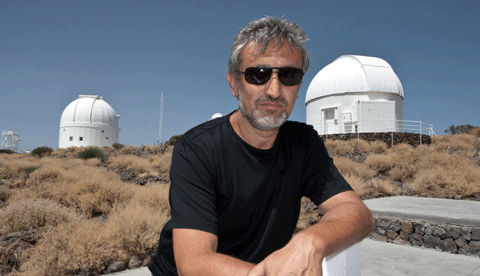How Armenian astrophysicist Garik Israelian rocked up in Spain
How Armenian astrophysicist Garik Israelian rocked up in Spain –
By Teresa Levonian Cole
Financial Times – “I don’t know why people have this idea that we were oppressed under the Soviet Union,” says Garik Israelian. “I remember a time of parties, a lot of fun. There was no unemployment, everyone had free apartments, people were very happy. It was different under Stalin, of course, but things changed with Khrushchev. Armenia was an exception in the Soviet Union — our language, culture and church were preserved and respected.”
Dr Garik Israelian, one of the world’s leading astrophysicists, was born in Yerevan in 1963 and is a grateful beneficiary of the Soviet education system. “I was a disaster at school,” he recalls. “I never studied — I just liked music.” To his family’s despair, he left school at 16, went to work in a theatre and indulged his passion for rock guitar, forming a band and playing in bars. “But then I saw [the film] Solaris and it changed me 180 degrees. I was so inspired. I started reading science fiction and decided to go to university. It meant I had to study maths and physics from the beginning, at home. But the great thing about the system then was that it didn’t matter how badly you did at school, so long as you passed the exams for university. Otherwise I would have had no chance.”
Studying astrophysics at Yerevan University, his supervisor was the renowned Viktor Ambartsumian, who established the USSR’s first department of theoretical astrophysics. “He came from Leningrad University to Armenia, where he founded the Byurakan observatory and directed the Armenian Academy of Sciences for 50 years,” says Israelian. “He was very famous, a genius.”
So it was with great reluctance that, on gaining his PhD in 1992, Israelian approached Ambartsumian for a letter of recommendation, to work abroad. “1988 [the year of the earthquake] to 1996 was the worst time in Armenia,” he says. “The Soviet Union collapsed. There was no money, no products in the shops, no electricity for six to eight months. I was writing my thesis by candlelight at night and working on a farm [by day]. It was very clear that if I stayed in Armenia, I would have to abandon science.”
He had already had a taste of the west, spending three months in 1990 at Armagh Observatory in Northern Ireland. “My first goal was to buy records,” he laughs. “It seemed incredible to me you could buy records in a store. I [had] heard The Beatles when I was five or six, and collected vinyl. So thanks to rock music, I had some English.”
Israelian left Armenia in 1993 with his wife Emma and baby son to take up postdoctoral fellowships, first in Utrecht then Brussels. “It was awful,” he says of those three years. “The climate was depressing, the people were depressing — a different mentality. All relationships were converted into business relationships. We’re not used to that.”
His next fellowship, in Sydney, proved happier. “Suddenly, there was sun,” he laughs. “So when the offer came of a fellowship in the Canary Islands [at the Institute of Astrophysics], it was a difficult choice.” Geography tipped the balance — “Australia was so far, travel was a nightmare” — so in 1997 the family moved to Tenerife. In 2006, Israelian became a permanent research scientist and today heads a project probing stellar chemical abundances. He lives in the north. “It’s very green, very beautiful, very quiet. You hear the birds. We have a garden on a hill, overlooking the sea.”
When not working — from home, at the University of La Laguna or at the observatories on La Palma — or conferences abroad, Israelian enjoys the wild habitat. “There are amazing mountains, volcanoes, forests, clean sea . . . It is the most beautiful island. I like to swim and snorkel, and I like to hike, usually alone, with my music so I can think. I used to hike in Armenia too. I believe in nature. Nature is my definition of God.”
Israelian also feels an affinity with the southern temperament. Although the Israelians keep the language and culture of Armenia alive at home, and return to visit family every summer, they feel part of the community. “I miss Tenerife when I’m away for a long time,” he says. “The people are very nice, very open, like Armenians. We have lots of friends, have barbecues and go to local restaurants and fish restaurants in La Punta. The food is good — and so cheap.”
His host country has embraced him with equal enthusiasm, not least for founding the Starmus Festival, an international gathering of leading scientists and musicians for concerts and talks, which will be held for the third time in 2016. “Everyone said it couldn’t be done,” says Israelian, who first brought Apollo and Soyuz cosmonauts, Nobel laureates and rock musicians together in 2011 and was awarded the Gold Medal by the government of the Canary Islands in recognition. Fluent in Spanish, Israelian was also fast-tracked for dual Spanish and Armenian citizenship.
For Starmus, Israelian enlisted the support of musician and astronomer Brian May, whom he had helped finish a long-abandoned thesis. “Brian was an inspiration. For me, it was like meeting my heroes,” he laughs, also citing musicians Rick Wakeman, Peter Gabriel and Tangerine Dream whom he has brought to the island, and scientists and astronauts such as Stephen Hawking, Martin Rees and Neil Armstrong. “The festival is all about encouraging people to come to Tenerife, inspiring them about science, and capturing their imagination.” Much, in fact, as Solaris did for him as a guitar-playing teenager in Armenia.

